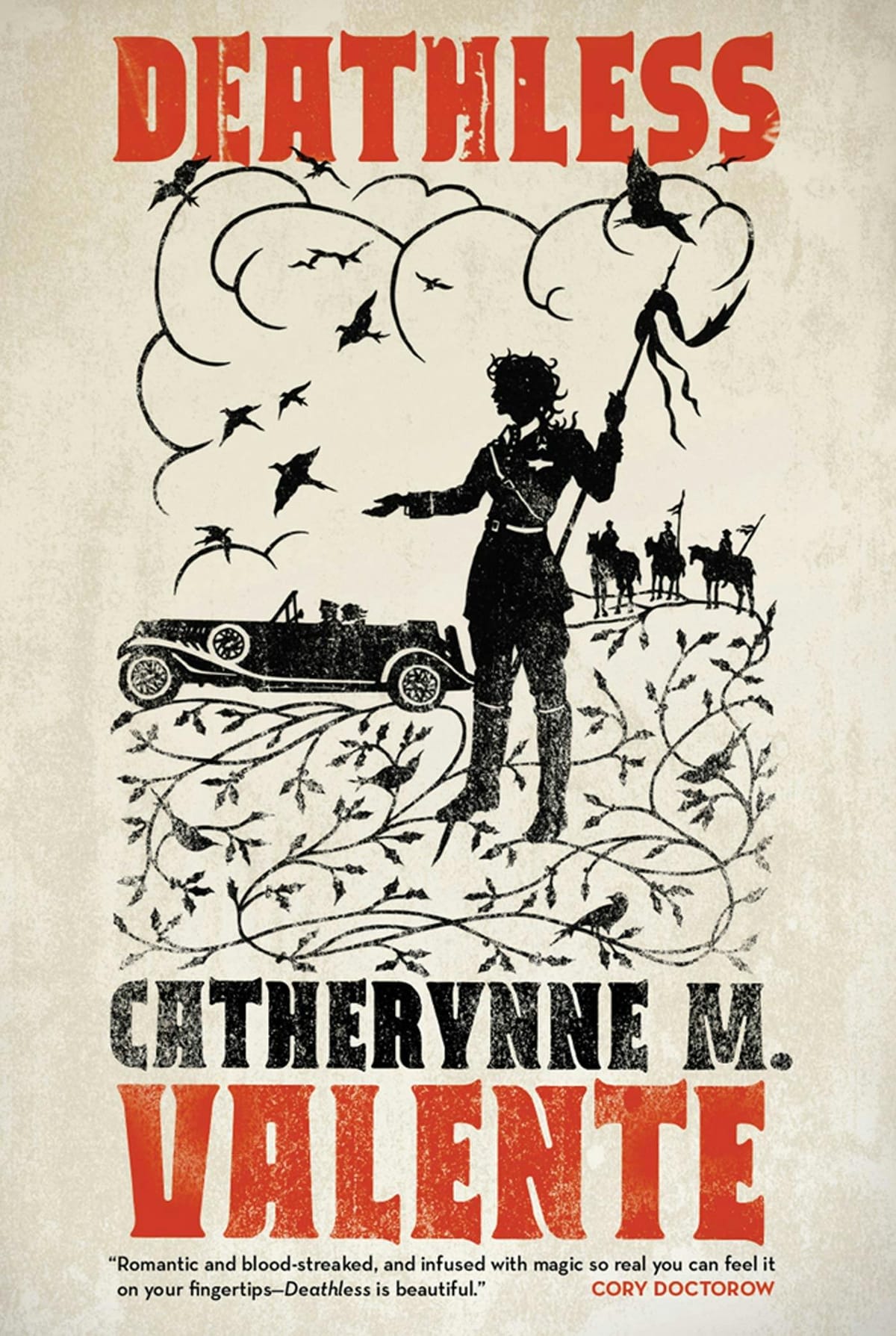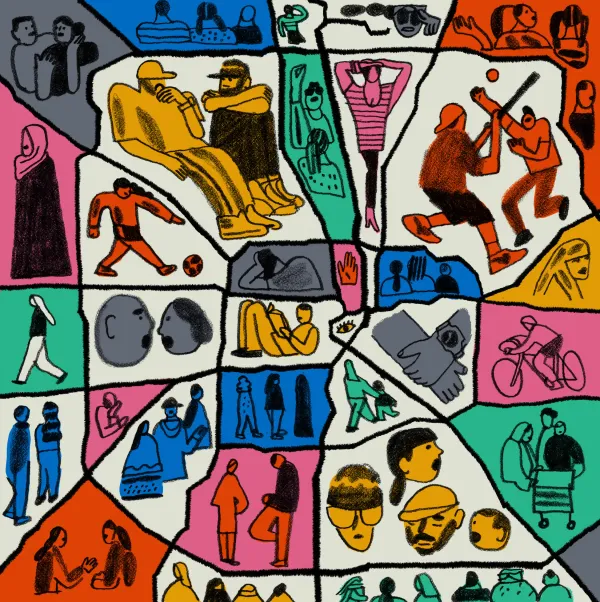Tsars, Birds, and Stalin, Oh My!: Deathless by Catherynne M. Valente
This is as romantic as Stalinist Russia gets.

Deathless is like no other book I have ever read. It is different, so utterly enrapturing that when I finished it at 4 AM, eyes dry and worn, I had already been crying for the previous twenty minutes. The novel stands alone, part folk tale, part historical fiction. Myths filled with spirits and gods mixed with Soviet-era Stalinist Russia. These two halves seem fundamentally incompatible with each other, and yet they are flawlessly woven together into one story, one book.
Valente does her job brilliantly. Marya Morevna starts out the story at just sixteen, and ends it about two decades later, having both experienced the fantasy world of her husband Koschei and life under the Russian Communist regime. Both worlds present their difficulties to her; Koschei is engaged in constant warfare with his brother; the Russian regime faces food shortages and a totalitarian climate that only worsens as Russia is drawn into World War II.
This book is a masterpiece, a testament and tribute to both Russian culture and history. Valente binds her story together with breathtakingly emotional writing, instilling in her reader the truest feelings of sympathy laid bare not only for Marya, but for everyone around her. Deathless is a statement about the difficult and sometimes wavering tenets of life and love, as well as a reminder that while each of us has our own journey to go on, fate is an unmovable force always eager to catch up with us.
We open the story on a series of strange occurrences: birds falling from trees and turning into young men when they land on the concrete below. Each of Marya's sisters is married to a bird-man, though Marya is the only one who knows their original form. This is one of the most charming parts of the story, when each of the bird-men sigh,
“This is not the girl in the window. But I will love her as though she was, for I see now that that one is not meant for me.”
The repetition of this statement not only implies to the reader that something is afoot, but also enhances the fairytale-like mood of the story—an excellent use of structuring.
The years pass. The Russian Revolutions come and go. Marya's house swells with the addition of eleven families, as per the new Communist spirit of sharing. Marya keeps to herself, though she takes the time to tell the reader of an important shift in her childhood:
She loved her scarf [...] it meant that she belonged. It marked her as part of the young workers' committee, one of the loyal, one of the true. It meant she was one of the good children at school, the children of the revolution [...] adults smiling at her scarf, at her goodness.
Marya unwittingly blurts out in class that she wonders what kind of bird Lenin had been before he became a man, thinking that birds turning into husbands is a common occurrence. Her classmates are horrified at what they perceive to be disrespect, and they slap and pull at her, stealing her scarf in the process. This is one of the most emotional parts of the book, especially when Marya begs her classmates to not take her scarf, as it is the only thing that truly belongs to her. From this moment on, Marya retreats into herself, vowing to keep her secret for herself.
In the third chapter, Marya witnesses the meeting of her house's domovoi, or protective gods. They are very different from spirits that I think most are accustomed to, such as fairies or unicorns or centaurs. Instead, the domovoi are crass and sneaky—even if they do have their humans' well-being at heart. Zvonok, Marya's domovoya, is kinder than her companions and features prominently every time Marya returns to Leningrad. (But more on that later.)
The domovoi's meeting is also where the reader first hears of Koschei, whom the domovoi refer to as "Papa Koschei."
“Just you wait,” he hissed. “Just you wait. Papa Koschei is coming, coming, coming, over the hills on his red horse, and he’s got bells on his boots and a ring in his pocket, and he knows your name, Marya Morevna."
Now, I went into this book expecting a romance story (that was what Goodreads told me!!) and hearing these tiny, terrifying spirits refer to the man I was expecting to be the primary love interest as some sort of ghoulish figure didn't help my idealized predictions of the book. But it turns out that Koschei is also immensely handsome—in fact, Zvonok even sighs at the thought, telling Marya that even though she wants to warn her about him, she knows that Marya will go with him in the end because his beauty hides his true self.
Koschei arrives for the first time, five-ish chapters in, and true to prediction, Marya cannot help but go with him. They sup and stay in various locations on their way to a secret destination; in each house, Koschei exercises a series of commands seemingly designed to motivate Marya to submit to him. By the end of the first third, they arrive at Koschei's domain—the Country of Life—and this is where the story truly starts.
This section opens with Marya fully assimilated into her new life under Koschei's rule. She has made three friends: an imp named Nastya, a forest spirit named Zemlya, and a beautiful nymph-like figure named Lebedeva. She spends her days in an idyll, hunting for sport and playing games with her friends. However, despite her integration, Koschei has not yet married her.
But alas! An answer to Marya's wishes for marriage appears in the form of the terrifying crone Baba Yaga—Koschei's sister and fellow tsarina. She taunts and mocks Marya—and eventually takes her to a factory where she learns about truth about Koschei's past.
Below, dozens upon dozens of girls worked away at looms the size of army trucks, their fingers flashing in and out of strands of linen, their shuttles racing their hands.
Koschei has done this dozens of times before. Baba Yaga doesn't hold back, gleefully telling Marya all about how he has a strange penchant for choosing Yelenas (although sometimes a Vasilisa will sneak in). But what did these girls do that earned them a lifelong position in a factory?
"Koschei, my insatiable brother, abducted all those girls—from Moscow, from Petrograd, from Novgorod, from Minsk. Spirited them from their cozy little homes, barreled them through the snow, telling them what to eat, how to kiss, when to speak, bathing them when they fell sick, just so they’d love him and need him.
But there's more. Every time the girls leave Koschei, they run off with men named Ivan. The men's are always Ivan, just as the women's names are always Yelena or Vasilisa. It is fate, and Marya cannot change it.
Baba Yaga then sets three tasks for Marya before she can marry Koschei. It's very reminiscent of the Psyche/Eros tale . . . or perhaps any folk tale. They are impossible tasks, all requiring the assistance of Marya's friends.
Eventually Marya succeeds in completing her tasks, returning to Baba Yaga victorious. She reluctantly sanctions Marya and Koschei's wedding—and here we get (probably) the most famous quote from the book (not to mention probably the only explicitly romantic one), delivered by Koschei:
“There need never be any rules between us. Let us be greedy together; let us hoard. Let us hit each other with birch branches and lock each other in dungeons; let us drink each other’s blood in the night and betray each other in the sun."
But just after they are wed, they are interrupted by an unwelcome guest: Koschei and Baba Yaga's brother, Viy—the Tsar of Death. He attacks the city and kills Marya's friends—displaying their bodies like a macabre tribute to her. War erupts between the lands of Life and Death, and Marya becomes something like a general, leading soldiers of Life.
But at this point, the reader is probably thinking to themselves, Marya and Koschei are married. And we're only halfway through the story, which means . . .
A young man shows up at Marya's war tent one day, handsome and charming. But before he goes in, he meets a bird-woman who tells him "everything that will ever happen to [him]."
“You have already gone into that tent. You have already made off with her. You have already lost her. You could tell your tale differently this time, I suppose. But you won’t. Your name will always be Ivan Nikolayevich. You will always go into that tent.”
Marya fights her attraction with all of her heart. She tells Ivan, point-blank, that she should put a bullet through him (no pun intended). But she doesn't. Instead, she brings him back to see her husband. Koschei is understandably angry—and Marya, despite herself, takes off with Ivan. She leaves her life behind. She leaves Koschei behind.
At first, everything is fine. Ivan is madly in love with her, and they move into Marya's old house in Leningrad. By now, all the families that once occupied it are gone. Only Zvonok is left. In her new (or is it old?) life, Marya no longer hunts or goes to war. Instead, she stays at home, cooking and cleaning. Ivan welcomes a woman and her baby into their home, who turn out to be water nymphs.
But it is the 1940s, and times are hard. Marya is unregistered; the whole house must live on Ivan's single ration. Marya begins to scrape the wallpaper off of the walls in order to cook some semblance of food. Despite this, the house is quite peaceful, and Marya is shown the life she would have had if she had not met Koschei—until one day. A day much like another, when the Tsar of Death shows up at her front door, begging to be taken back.
Marya Morevna turned the knob and opened her door onto the city [...] A man looked down at her, for he was quite tall. He wore a black coat, though the evening's warm wind blew through his curly dark hair, so like a ram's. Slowly, without taking his eyes from hers, the man in the black coat knelt before her.
There’s another narrative shift here. Instead of Marya’s POV, Valente switches to another character. An unlikely candidate. Indeed, it’s Zvonok that takes over the storytelling. And in classic domovoi fashion, she injects her acerbic wit into the story, documenting Marya’s secret visits to Koschei during the day. But the reader also gets a better glimpse into Zvonok’s fierce dedication to her family. In one scene, when everyone is starving, she manages to trade stolen diamonds for meat—the first real food that the family has had in years.
Things begin to break down irretrievably after that. Food runs lower than ever. And then, Ivan completely loses it. I don’t think any of us were sorry to see him go down into the basement and be completely shocked out of his skin by Koschei. (At least, I wasn’t.) And I’m fairly certain Marya wasn’t either, because when Koschei regains his strength, she leaves Leningrad—and Ivan—with him.
Koschei spirits Marya away to a quaint, beautiful little village where she does not remember herself as Marya Morevna, one-time tsarina and wife of Koschei and Ivan, but as Marya, wife of Koschei Bessmertny and neighbor to just about the nicest people around.
Neighbors with names like Vladimir Ilyich, Josef, Leon, Nikolai Aleksandrovich, and Aleksandra Feodorovna. And once I realized who they truly were, I began tearing up. I can’t explain why. Perhaps it was the idea that all of these people—real people—in conflict with each other could live peacefully in someone’s mind. Or perhaps it was the realization that Marya and Koschei hadn’t actually been given their happy ending. Instead, they lived in a dream world where nothing made sense.
Eventually, Marya becomes pregnant—but not without some eyebrow-raising events. She confesses to Aleksandra that Koschei has been strangely distant about the idea of children, imploring her to hold off on having them. But eventually he gives in, and nine months later, their daughter is born.
If only it were as simple as that.
It turns out that their daughter is actually Koschei’s death. (And no, even after some 300-odd pages of talking about his death, I don’t understand.) What follows her birth is probably one of the strangest things I’ve ever read. Their daughter grows up into a girl before their eyes, and when Koschei goes to embrace her, he melts. Yup. He melts, like a chocolate bar in the sun.
And here is where the reader gets the explanation that is owed to them. Told by the Tsar of Birds, Marya finds out that the world she and Koschei have been living in has been a dream, and that she was on the brink of death when Koschei spirited her away. But more importantly, she is told that Koschei could have easily saved himself from death.
“Here [in the dream world], he could be yours, he could be whole, both Koschei and Ivan, devil and man, powerful and weak, dark and gold. You could be the girl you might have been, if you had never seen the birds. If you had never had your scarf stolen.”
Marya returns to Leningrad and finds Ivan on his deathbed. They profess their love to each other (even though at this point I’m rolling my eyes at anything Ivan claims) and he dies. From there, Marya joins the Russian army, aided by a fellow soldier. But even this soldier does not seem to be who they claim they are, and they reveal themselves to be a golem, their sole purpose to look for Marya and make her remember who she is. And at the very end of the story, Marya finds herself in an impossible town. A town where all her friends are alive and everyone is happy and well and Koschei is married to Yelena with no Ivan to come between them. It is as if everything worked the first time, and there was no need for a Marya to change the story.
Marya Morevna looked up, and she felt so old, so awfully old and worn, and so young all at once, raw as a wound. Let it be over, she pleaded within herself. Let it never have happened—any of it. Let me be young again, and the story just starting.
But there is a chance. For somewhere underground, in a basement, there is a handsome man waiting to meet Marya, to say her name.
This ending wrecked me in countless ways. Rereading it right now is still making me cry, and it’s been an entire month. The feeling of knowing that your time has passed and that you cannot do anything to fix it struck me hard. Marya had everything she ever wanted when she was married to Koschei Bessmertny, and even that was a lie.

